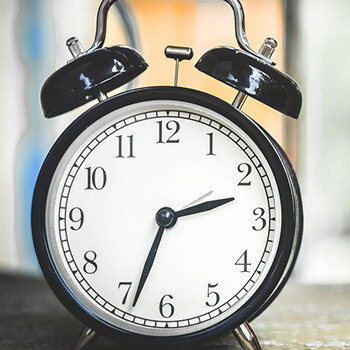Adjusting to Daylight Saving Time

As the old adage goes, remember to Spring forward on March 11.
By Pulmonary, Critical Care, and Sleep Medicine Physician Katherine Dudley, MD.
In March we lose an hour of sleep with the onset of daylight saving time and it is not until November that we gain an hour of sleep back. In 2018, the clocks will go forward by one hour on Sunday, March 11, starting at 2 a.m. Mark your calendars!
Here’s a fun fact - Some parts of the United States avoid daylight saving time altogether. Hawaii, Puerto Rico, Guam and Arizona (minus Navajo lands) do not participate. Lucky them.
Waking up the next Monday morning might be arduous as we adjust to a new schedule. An extra cup of coffee might be required. Depending on your personal, work and family context the impact can vary, especially if you have young children. Kids need more sleep generally and have a lower tolerance for changes to their routines. Older folks and individuals with chronic conditions also struggle.
The symptoms caused by the shift in time are similar to a slight case of jet lag and can take anywhere from two days to a full week to properly recover. The common rule of thumb is for every hour of sleep lost 1-2 days are needed for your body to adapt.
There are a few simple steps that everyone can take, a week or so in advance of the event, to mitigate the impacts. Below are a few of my top suggestions.
- Stick to a routine - As saving time begins it's important to keep with a bedtime routine. An hour or so before bed reduce exposure to blue light from the computer, phone, TV, or tablet. Keep the lights dim in your bedroom and see if reading (not on a tablet) helps relax your mind and body.
- Reduce caffeine and alcohol - A week or so before the time change begins, stem that extra cup of coffee or an occasional glass of wine in the early evening or afternoon. Reducing the intake of these beverages will help your sleep cycle shift organically.
- Increase exposure to light and warmth - Consider integrating exercise or a walk, for 30-40 minutes, in bright light into your morning or lunchtime schedule. Taking in light, and natural heat, throughout the day helps you stay awake and alert.
Daylight saving time signals the beginning of longer and warmer days, fun outdoor activities and time with friends and family so get out there and enjoy the weather!
Disclaimer
This articles provide general information for educational purposes only. The information provided in this article, or through linkages to other sites, is not a substitute for medical or professional care, and you should not use the information in place of a visit, call consultation or the advice of your physician or other healthcare provider.